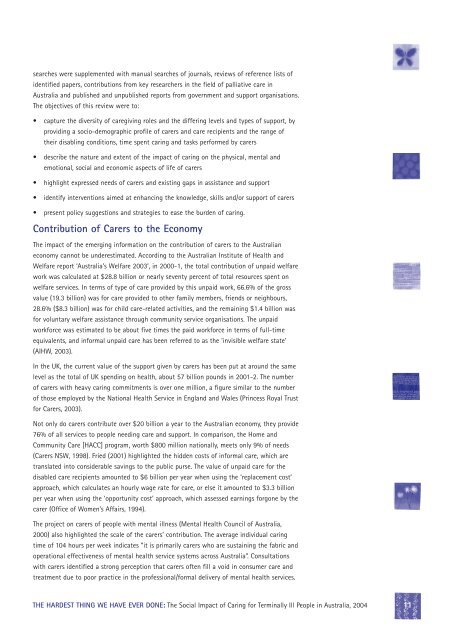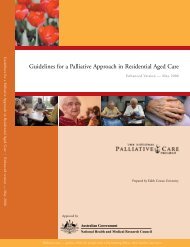The hardest thing we have ever done - Palliative Care Australia
The hardest thing we have ever done - Palliative Care Australia
The hardest thing we have ever done - Palliative Care Australia
Create successful ePaper yourself
Turn your PDF publications into a flip-book with our unique Google optimized e-Paper software.
searches <strong>we</strong>re supplemented with manual searches of journals, reviews of reference lists of<br />
identified papers, contributions from key researchers in the field of palliative care in<br />
<strong>Australia</strong> and published and unpublished reports from government and support organisations.<br />
<strong>The</strong> objectives of this review <strong>we</strong>re to:<br />
• capture the diversity of caregiving roles and the differing levels and types of support, by<br />
providing a socio-demographic profile of carers and care recipients and the range of<br />
their disabling conditions, time spent caring and tasks performed by carers<br />
• describe the nature and extent of the impact of caring on the physical, mental and<br />
emotional, social and economic aspects of life of carers<br />
• highlight expressed needs of carers and existing gaps in assistance and support<br />
• identify interventions aimed at enhancing the knowledge, skills and/or support of carers<br />
• present policy suggestions and strategies to ease the burden of caring.<br />
Contribution of <strong>Care</strong>rs to the Economy<br />
<strong>The</strong> impact of the emerging information on the contribution of carers to the <strong>Australia</strong>n<br />
economy cannot be underestimated. According to the <strong>Australia</strong>n Institute of Health and<br />
Welfare report ‘<strong>Australia</strong>’s Welfare 2003’, in 2000-1, the total contribution of unpaid <strong>we</strong>lfare<br />
work was calculated at $28.8 billion or nearly seventy percent of total resources spent on<br />
<strong>we</strong>lfare services. In terms of type of care provided by this unpaid work, 66.6% of the gross<br />
value (19.3 billion) was for care provided to other family members, friends or neighbours,<br />
28.6% ($8.3 billion) was for child care-related activities, and the remaining $1.4 billion was<br />
for voluntary <strong>we</strong>lfare assistance through community service organisations. <strong>The</strong> unpaid<br />
workforce was estimated to be about five times the paid workforce in terms of full-time<br />
equivalents, and informal unpaid care has been referred to as the ‘invisible <strong>we</strong>lfare state’<br />
(AIHW, 2003).<br />
In the UK, the current value of the support given by carers has been put at around the same<br />
level as the total of UK spending on health, about 57 billion pounds in 2001-2. <strong>The</strong> number<br />
of carers with heavy caring commitments is over one million, a figure similar to the number<br />
of those employed by the National Health Service in England and Wales (Princess Royal Trust<br />
for <strong>Care</strong>rs, 2003).<br />
Not only do carers contribute over $20 billion a year to the <strong>Australia</strong>n economy, they provide<br />
76% of all services to people needing care and support. In comparison, the Home and<br />
Community <strong>Care</strong> [HACC] program, worth $800 million nationally, meets only 9% of needs<br />
(<strong>Care</strong>rs NSW, 1998). Fried (2001) highlighted the hidden costs of informal care, which are<br />
translated into considerable savings to the public purse. <strong>The</strong> value of unpaid care for the<br />
disabled care recipients amounted to $6 billion per year when using the ‘replacement cost’<br />
approach, which calculates an hourly wage rate for care, or else it amounted to $3.3 billion<br />
per year when using the ‘opportunity cost’ approach, which assessed earnings forgone by the<br />
carer (Office of Women’s Affairs, 1994).<br />
<strong>The</strong> project on carers of people with mental illness (Mental Health Council of <strong>Australia</strong>,<br />
2000) also highlighted the scale of the carers’ contribution. <strong>The</strong> average individual caring<br />
time of 104 hours per <strong>we</strong>ek indicates “it is primarily carers who are sustaining the fabric and<br />
operational effectiveness of mental health service systems across <strong>Australia</strong>”. Consultations<br />
with carers identified a strong perception that carers often fill a void in consumer care and<br />
treatment due to poor practice in the professional/formal delivery of mental health services.<br />
THE HARDEST THING WE HAVE EVER DONE: <strong>The</strong> Social Impact of Caring for Terminally Ill People in <strong>Australia</strong>, 2004<br />
11
















